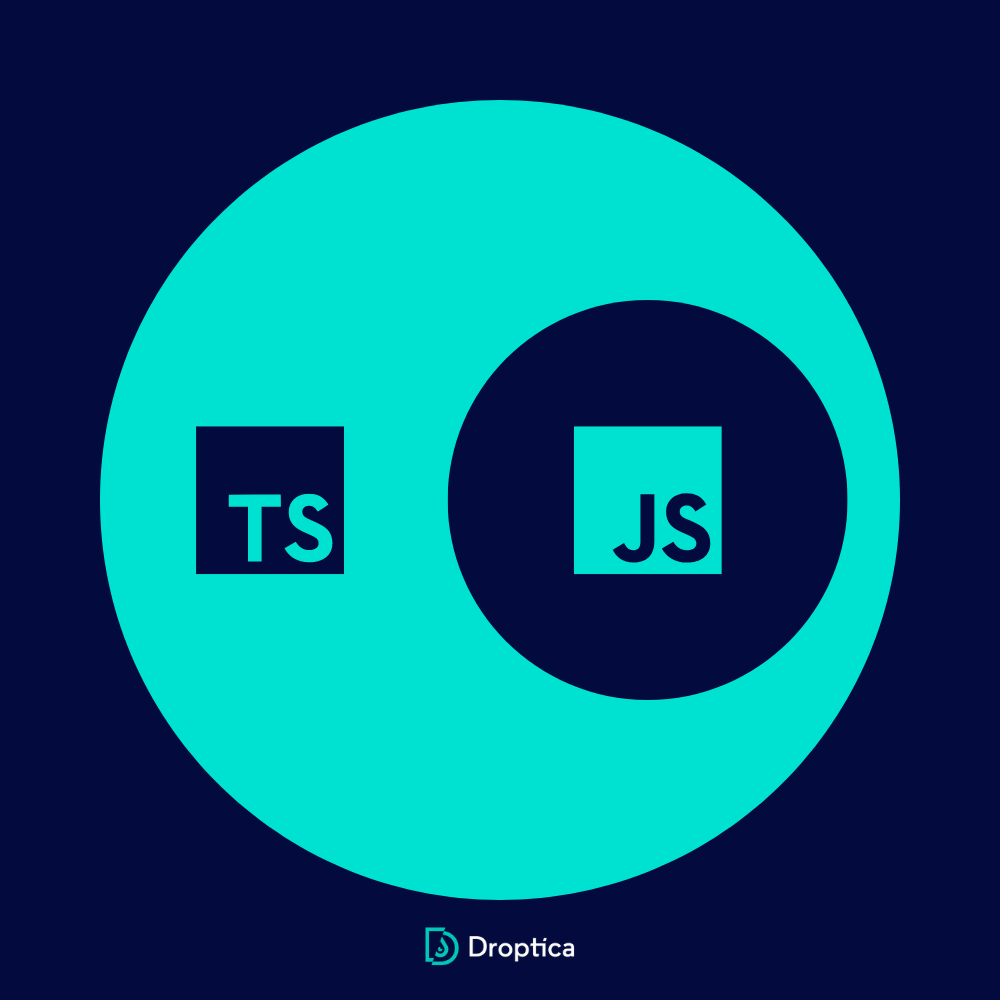
TypeScript vs JavaScript. 6 Main Differences Between the Languages
JavaScript and TypeScript - two programming languages that, at first glance, seem inseparable. However, what are the real differences between them? Is TypeScript simply JavaScript with add-ons, or is it something more? In this article, we will take a closer look at both languages, compare their functions and consider when to choose one over the other.
What is TypeScript vs JavaScript?
JavaScript, based in 1995, is a dynamically typed language, that is, one where the types of variables are determined as the program runs. JS is used to create websites and web applications. It’s one of the three primary technologies used to build the frontend, next to HTML and CSS.
On the other hand, TypeScript, created by Microsoft in 2012, is a superset of JavaScript. It means that it contains all the JS elements but adds static typing and other features characteristic of full-fledged programming languages, such as enumerations and namespaces. TypeScript was developed to provide better tools for large applications, offering features such as static types and interfaces, allowing easier-to-maintain code.

With Node.js, JavaScript can be used as a server-side language. So can TypeScript. However, when we create both the frontend and backend in TS, the static typing mentioned above allows us to develop interfaces that we use on both sides of the barricade, which consequently ensures data consistency and better validation.
Market
Although TypeScript is still less popular than JavaScript, it’s gaining more popularity than JS each year. This is also followed by a larger community that provides new solutions. One of them is the highly regarded Angular framework, which is written in TypeScript, and using it requires writing code in that language. Zod - a library that validates data and allows for better data definition - was also created in TS.
Compatibility
TypeScript is a superset of JavaScript, meaning that most JS code should also work without problems in TS. However, because of TypeScript's additional features, such as static typing, developers must be aware of the differences between the languages to avoid potential errors.
What are the differences between TypeScript and JavaScript?
Despite many similarities, there are several key differences between TypeScript and JavaScript. These affect how the two languages are used in practice and can be decisive in choosing one for a particular project.
Typing
JavaScript is a dynamically typed language, which means that the types of variables can be changed during code execution. This gives programmers great flexibility but also increases the risk of errors. On the other hand, TypeScript introduces static typing, which improves type safety and allows typing errors to be detected even before the code runs, thanks to tools built into the IDE (Integrated Development Environment). This contributes to more excellent code reliability and readability but can also slow down the process of writing smaller applications.
Classes and interfaces
JavaScript ES5 doesn’t natively support classes and interfaces, which are fundamental to object-oriented programming. TypeScript, on the contrary, provided support for these concepts. This allowed developers to create more complex and organized code structures, which was particularly useful for large projects.
Modularity
TypeScript offers better control over modules through namespaces, allowing for more organized and manageable code structures.
Tools
The community built around TypeScript has provided powerful tools for developers, such as intelligent code completion, refactoring, and compile-time type checking. These features enable developers to write more efficient and error-free code. JavaScript doesn’t offer this level of tool support.
Compilation
TypeScript is a transpiling language, meaning that code written in TypeScript must be converted to JavaScript to be run in a browser. This is necessary because web browsers are unable to interpret TS code directly. JavaScript, on the other hand, is an interpreted language, which means it’s read and executed directly by the browser line by line. Therefore, when choosing between TypeScript and JavaScript, programmers must decide whether the additional benefits of using TS are worth the extra step of transpiling.
When to use TypeScript vs JavaScript?
The decision between JavaScript and TypeScript depends on many factors, such as the complexity of the project, performance and security requirements, as well as the skills of the development team. The latter is particularly important, as TS has a significantly higher entry threshold for novice developers, but over time the complexity of the project doesn’t progress as quickly as with JS.
JavaScript is ideal for smaller projects that require speed of execution and flexibility. Because of its dynamic typing, JavaScript is often faster to write, mainly for small, simple applications.
On the other hand, TypeScript works best for larger, more complex projects that require more code organization and security. The static typing, interfaces, classes, and other functionalities available in TypeScript can provide significant benefits regarding code scalability and maintenance.
In addition, TypeScript is often preferred or even required in projects using the latest libraries and frameworks, such as Angular or React, due to better tool support or framework construction.
How to combine TypeScript with JavaScript?
TypeScript and JavaScript can be effectively used together in a single project. This is often a good idea for large, complex applications. TypeScript, being a superset of JavaScript, allows direct use of JS code inside its environment. Thus, it’s possible to gradually add TS to an existing JavaScript project without rewriting all the code. However, the process must be well-planned and divided to happen smoothly.
For example, we can start by introducing TypeScript to key parts of the application that need more type safety and better tooling support, such as intelligent completion or code refactoring. Then, as the team becomes more familiar with TypeScript, it can be deployed to other application parts.
One of the strengths of this approach is that it enables teams to take advantage of the TypeScript benefits while minimizing the risks associated with large, one-time code changes. This is particularly valuable in projects already underway and could benefit from the additional advantages of using TS. Automated tests give more freedom when it comes to refactoring, as they minimize the possibility of regressions after changes are made. For this reason, having as high a percentage of test coverage as possible before refactoring is a good idea.
JavaScript vs TypeScript - summary
TypeScript and JavaScript have unique characteristics that make them suitable for different project types. The choice between the two should depend on the project's specifics, the client's requirements, and the team's skills. Remember that regardless of the selection, it’s important to play to the strengths of each of these languages, understand their differences, and know the best practices to effectively and safely develop applications. Our team of programmers working on frontend development will be happy to help you create a website based on the technology selected for you.












